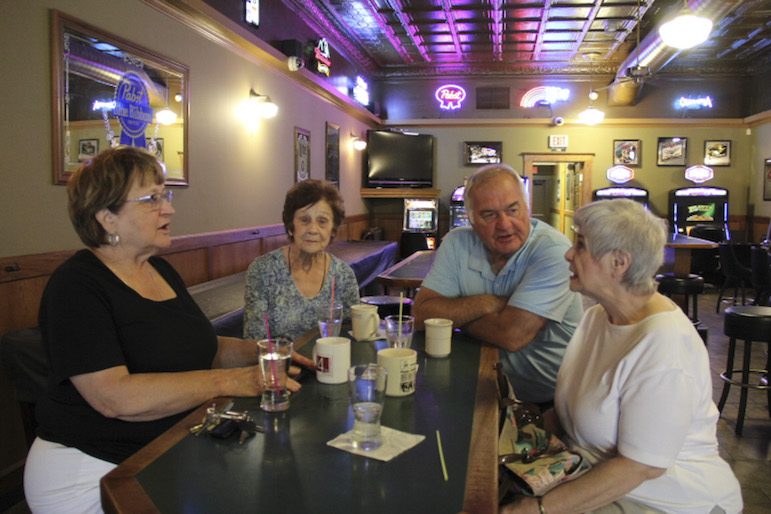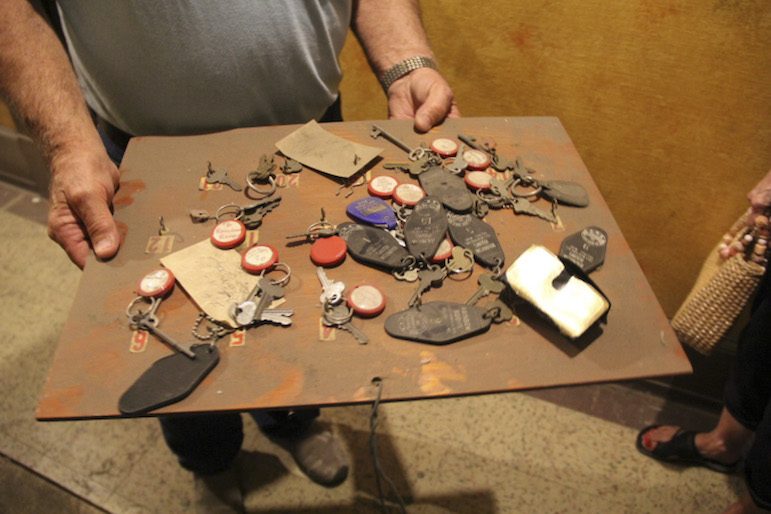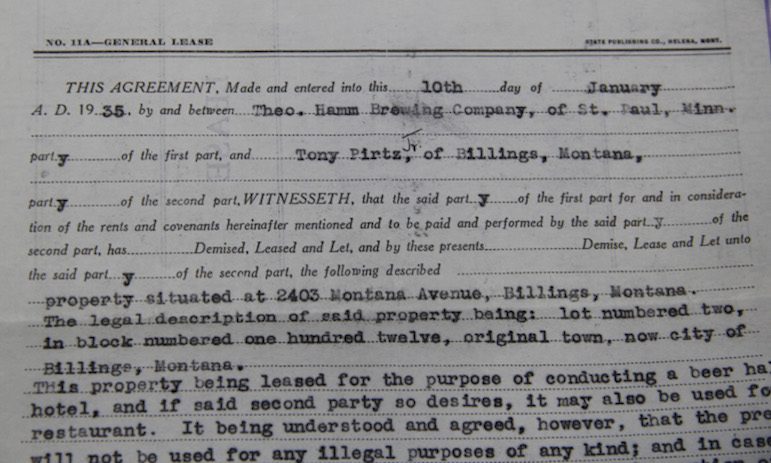Family’s roots go deep in 81-year-old Rainbow Bar

Ed Kemmick/Last Best News permalink
Linda Jacobson, left, who runs the Rainbow Bar, reminisced about the history of the family-owned tavern with her Aunt Mary "Mitzi" Hartman, brother Frank Jr., and cousin Sandy Sherman.

Ed Kemmick/Last Best News permalink
Frank Pirtz Jr. shows a collection of room keys from the old hotel above the Rainbow.
Ed Kemmick/Last Best News permalink
Bathrooms for ladies and gents were at the end of the hall in the hotel above the Rainbow.

Ed Kemmick/Last Best News permalink
The name of Ma Pirtz's son Tony appeared on the agreement when she leased the Rainbow building from the Theo Hamm Brewing Co., of St. Paul, Minn., in 1935.
Like most long-established taverns in Billings, the Rainbow Bar has always had a fair number of regulars.
It’s doubtful any of them are quite as regular as Linda Jacobson. Besides having run the Rainbow for just over 30 years, she lived in rooms behind the bar as a kid and has spent virtually all of her life in and around the Montana Avenue tavern.
When she was young, the parking lot that stretches from the old Beanery to Carter’s Brewing and the Railyard Ale House was a long, wide stretch of grass.
“That was pretty much our playground,” Linda said, referring to herself and as many as a dozen other kids who lived above or behind businesses that lined Montana Avenue near what was then the Northern Pacific Depot.
Linda is the third generation of her family to run the ’Bow, as it is often called, which her grandmother Mary “Ma” Pirtz opened as a beer parlor and hotel in 1935.
“You think Betty Friedan and Gloria Steinem were women’s libbers?” Linda asked. “Let’s talk about my grandma.”
First we should talk about her grandpa. Linda sat down in the Rainbow recently to reminisce about the history of the tavern and her family, joined by her brother Frank Pirtz Jr., their aunt Mary “Mitzi” Hartman, and Mitizi’s daughter Sandy Sherman.
The family patriarch was Anton Pirtz, a Slovenian who came to America in the early 1900s. He worked in New York state as a coal miner for a couple of years before ending up in Aldridge, near Livingston, where he also worked as a coal miner.
Anton heard reports of a fair maiden back in the old country and proposed to her by mail. When she accepted, he sent her money for the passage to America. In 1909, Mary, then 19, traveled by train from New York City to Livingston. Speaking no English, she wrote her destination on a piece of paper and pinned it to her coat.
Mitzi said family lore has it that when Mary arrived in Livingston, Grandpa Pirtz hid behind a pillar at the train depot, hoping to ascertain whether she was as good-looking as he’d heard. Apparently she was, and they were married three days later.
They moved to Roundup a few years after that, where their first child, Frank “Tiny” Pirtz, was born in 1911. They would eventually have five more children: Tony, Joe, Mitzi, Violet and Matt, who was killed in World War II.
Long before they opened the Rainbow, Anton and Ma Pirtz had a quite different liquor business: both of them were bootleggers in the Roundup-Kline area.

This undated photo shows Mary “Ma” Pirtz on the right, in Roundup, with her sister-in-law Margaret Nose. They were both bootleggers.
At this point in the conversation, Frank Jr. objected to the characterization of his grandparents as bootleggers.
“No, no, it’s only bootlegging when you sell it,” he said.
Mitzi, 93, gave her nephew a long look and smiled. “They did sell it, honey,” she said.
“Everybody in Roundup was a bootlegger” in those days, Linda added. In fact, at home she has her maternal grandmother’s homemade still.
At any rate, Ma Pirtz raised her children in Roundup until 1935, when she moved to Billings to start a beer parlor. Linda’s not quite sure how it came about, but her grandmother originally leased the building at 2403 Montana Ave. from the Theo Hamm Brewing Co., of St. Paul, Minn.
The lease was actually with her son Tony, apparently because a man’s name had to be on it. The document said the building was being leased “for the purpose of conducting a beer hall and hotel.”
Linda said Hamm Brewing apparently used the building for beer storage before leasing it to Ma Pirtz. Linda has the lease, which was signed on Jan. 10, 1935.
“I found that in a box of my grandmother’s junk just last year,” she said.
Ma Pirtz bought the place outright a few years later and at some point converted it into a full-service bar. Linda said her grandmother was mentored by Peter Yegen Sr., who may have been her real estate agent when she leased it. He showed her how to do the bookkeeping and schooled her in other aspects of running a business.
How did it come to be called the Rainbow?
“Back in those days, every town had a Rainbow and they all had the same sign,” Linda said.
The year after their mother opened the beer hall, Mitzi and her sister Violet moved to Billings. The two sisters lived above the bar in rooms that looked down on Montana Avenue. Down a long, narrow hallway behind their rooms was a 15-room hotel that Ma Pirtz also ran.

Ed Kemmick/Last Best News
The Rainbow Bar has been in the same family since it opened in 1935.
Mitzi later cleaned hotel rooms and she remembered once, feeling sorry for an old bachelor who lived in one of the rooms, she darned his socks for him.
Frank Jr. and Linda were the oldest of six children. They were born in Roundup and moved to Billings with their father, Tiny, in 1946, so he could help Ma Pirtz run the Rainbow. Linda was 3 and Frank Jr. was 5.
They lived in rooms behind the bar on the first floor, where the restrooms are now, and their grandmother’s kitchen extended into what is now the northwest corner of the tavern. They lived there only a couple of years before their father bought a house two blocks away on North 22nd Street. But Linda and Frank Jr. continued to hang out on Montana Avenue because all their friends still lived there, and almost all of them, like the Pirtzes, went to Catholic school.
Linda said that when she sees an old black-and-white movie about Chicago or New York, where the grandmother opens a window and calls all the kids in from the street for supper, the memories come flooding back.
“That’s kind of the way I grew up,” she said.
Their Uncle Tony eventually opened the Mint Bar barely two blocks west of the Rainbow, in what is now the post office parking lot. Meanwhile, Uncle Joe had a barbershop a block away in the other direction.
Montana Avenue was still a two-way street paved with bricks. The trolley that ran down Montana when Mitzi was a child was gone by the late 1940s.
There was a lot to do on the avenue back then. There was the big Chapple Drug Store, a lunch counter, a shoe-repair shop, a news agency (where magazines and out-of-town newspapers were dropped for re-distribution) and several hotels similar to the one above the Rainbow.
There were shoeshine boys and boys hawking newspapers and there were lots of freight trains and passenger trains disgorging riders all day long.
Mitzi recalled that the Rainbow was frequented by lots of families. Friday was a big day because people would come in to cash their paychecks and then hang out in the bar for a while.
Linda said one regular gave Ma Pirtz money to care for his grave after he died. Pensioners would give their checks to Tiny and he would deposit them in the safe and dole out cash to them, so they weren’t walking around with wads of money.
Linda was good friends with a daughter of the Stauntons, who ran the Rex Hotel next to the Rainbow. When Linda and the daughter were in grade school, they’d fill in on the hotel switchboard for Mrs. Staunton, patching through incoming and outgoing calls.

Ed Kemmick/Last Best News
Mary “Mitzi” Hartman, left, and her niece Linda Jacobson look at one of the old hotel rooms above the Rainbow Bar.
Linda also remembers her parents giving her and Frank 10 cents each to go to the movies at the Babcock Theater. It cost a nickel to get in, with a nickel for candy.
The Pirtzes and most everybody else on the block belonged to the Little Flower Catholic Church, and on Good Friday Mitzi would bring a carload of nuns from the parish to the Rainbow, where they drank wine out of jelly jars and ate potica, Slovenian sweetbread. Every Sunday, Ma Pirtz would make a big dinner and all the relatives would come over.
Tiny worked for his mother at the bar for many years until buying her out in 1963. Frank Jr. remembers his father counting out eight $1,000 bills that he gave Ma Pirtz as the final payment on the Rainbow.
Tiny was a hard worker. His children said he worked seven days a week all year long except for a two-week vacation to go elk hunting in October. Ma Pirtz would open the bar at 8 a.m. and Tiny would come in at 10, staying until 2 or 3 the next morning.
There were always lots of regulars, and even in the winter there’d be eight or 10 of them lined up, waiting for the 8 a.m. opening. The regulars watched out for each other. If one of them failed to show up, somebody would swing by their house or apartment to check on them.
“It’s like church,” Linda said. “Everyone had his stool.”
Years after Ma Pirtz died, Linda said, one old regular told her, “Your grandmother gave me my first credit back in 1936.”
Another regular, who was flush at the beginning of the month, like so many who lived on pension checks, once told her, “I will never leave my bill unpaid unless I die at the end of the month.” Sure enough, he did die at the end of the month, with $40 still owing on his bar tab.
Frank Jr. started working at the bar right after his 21st birthday, in 1962. His father and grandmother told him there were three rules: You don’t buy anybody a drink, you don’t let anyone buy you a drink, and you never drink behind the bar.
They didn’t buy drinks for anyone because their drinks were always, and notoriously, the strongest in town. Everywhere else, Frank Jr. said, a single meant one shot. At the Rainbow, a single meant two and a half shots.

Ed Kemmick/Last Best News
A property abstract for the Rainbow Bar features a hand-drawn map of the section of Montana Avenue on which the bar sits.
Once, Frank said, a couple of auditors came in, suspicious about how much booze the Rainbow claimed to be going through. They thought maybe Tiny was exaggerating how much he used to pad his expenses. But then they sat at the bar and watched Tiny pour drinks.
“They could understand why the Rainbow didn’t make the same percentage as the other bars,” Frank Jr. said.
Frank Jr. worked at the bar until he was 30, when he started his own construction company, doing projects in Montana and neighboring states. He eventually settled in Rock Springs, Wyo., and recently retired.
Linda, meanwhile, had always run errands for her father, and she began running the bar in 1985, when he became ill with cancer. He died the same year and Linda has been at it ever since.
Her job is to run the business end of things, paying bills, ordering supplies, taking care of the employees. She’s in the bar every morning for a few hours and then works at home the rest of the time. She’s only worked behind the bar a handful of times, when no one else was available.
By the time Linda took over, running the hotel was no longer part of the job. After the spectacular MGM Grand fire in Las Vegas in 1980, fire codes were changed nationwide and hotels like the one above the Rainbow were shut down for good.
Meanwhile, in the Rainbow, some of Tiny’s legacy lingers, including his odd habit of never taking pennies to the bank. For some reason he’d fill plastic beef jerky jars with all the pennies the bar took in, and when each jar was full he’d put it in a defunct double freezer.
“I took two jars to the bank yesterday and got $28,” Linda said. “I’m still getting rid of pennies.”
The Rainbow was traditionally a workingman’s bar, but it acquired a reputation as a quasi-dangerous dive starting in the late 1970s, when the downtown as a whole went into decline. The bar still attracted mostly retired workers during the day, Linda said, “but the evenings were sketchy.”
She said they tried to keep the prostitutes out of the bar, unless it was really cold, when they’d let them stand just inside the front door, next to the shuffleboard game.
Starting in the mid-1990s, business owners began a slow but steady redevelopment of Montana Avenue. Eventually, Linda said, she and her family understood that “we had to be part of the neighborhood. We can’t be the dive bar.”
And in 2006 she expanded and completely remodeled the place, so much so that some of the younger crowd, who liked the Rainbow for its seediness, were a little disappointed. Linda admits it’s a big change from the old days.
“We even have fruit in our drinks now,” she said. “We’re uptown.”
Comments
comments











